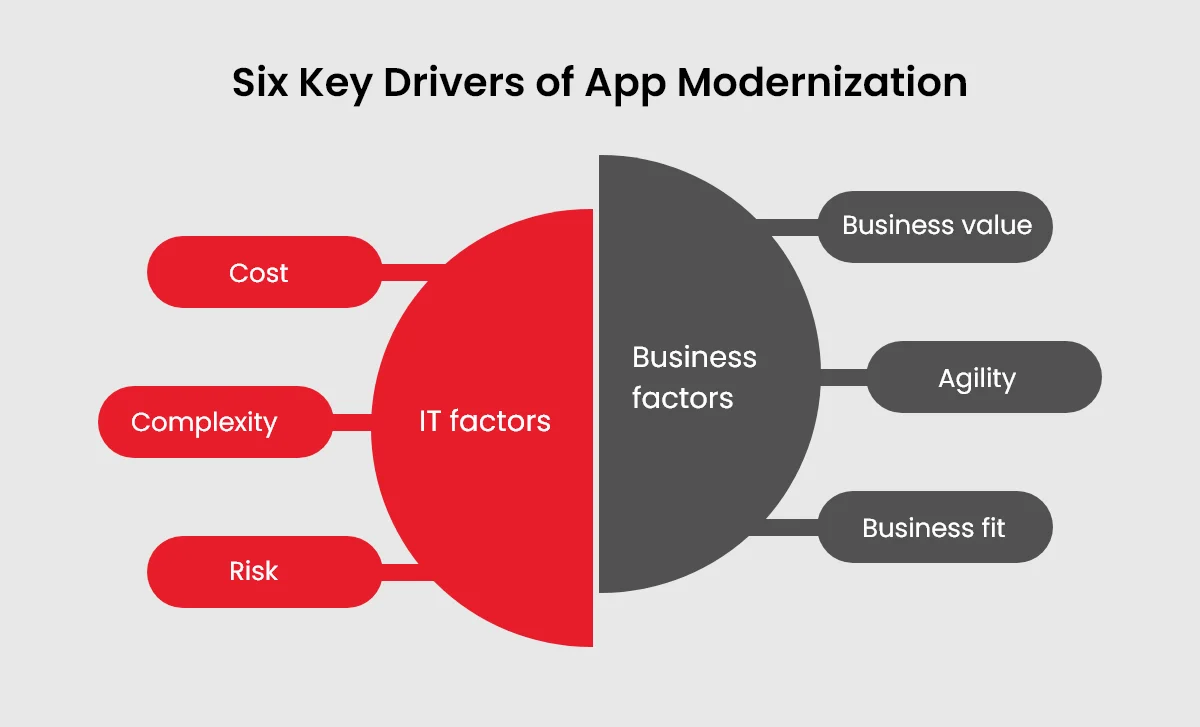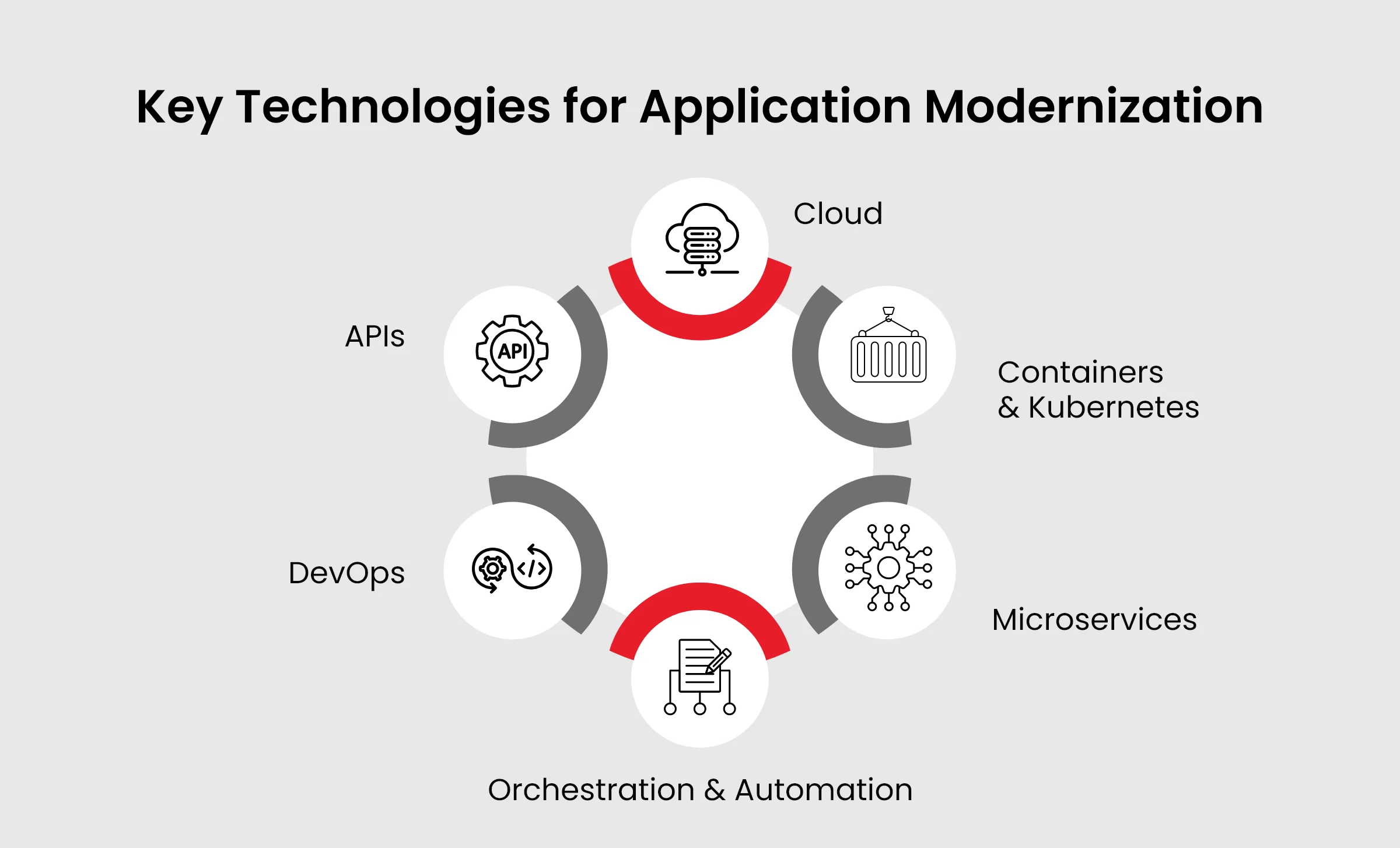Modernization is not merely shifting your mission-critical apps to a new platform. If you think so, your project is going to fail terribly like 79% of projects did. App modernization is not something you can decide or act upon in a hurry. It must be done carefully with the right approach and plan. In our guide, we will tell you how to modernize your legacy apps.
Step 1: Analyze Your Legacy System
The first step is very crucial as everything depends on it. To evaluate your legacy systems properly, examine the six key drivers related to your business and IT.
These drivers are mentioned by Gartner and tell you when you need to upgrade.

- If your legacy apps/systems are not meeting the current business requirements.
- If they are not providing real value to your business or customers.
- If they are not meeting the business demands of today’s digital landscape.
- If there is a high cost of ownership.
- If the technology of legacy apps or software is very complex.
- If the application exposes your business to risks of security and compliance.
The first three are important from a business perspective whereas the last three are IT related.
There are many more hints to evaluate the need to modernize your legacy systems. All these helps you understand the ‘why’ before you learn how to modernize your legacy systems.
Step 2: Pick a Right Approach
Following the right approach is as important as identifying the right opportunity. There are seven standard approaches for legacy app modernization. Each has a different level of risk and implementation.
The 7 R’s of app modernization
Retire: Remove applications from your IT portfolio that are either not necessary or useful. This will save costs on maintenance and optimizing the existing code. It also helps you focus only on high-demand apps.
Rehost: Move your business-critical apps to the new infrastructure without making changes to its current code. It makes app migration faster and easier. You can either do it manually with the help of your IT team or automate the process. With this ‘lift and shift’ approach, you can save the upfront cost of app modernization.
Replatform: Move the app to a new platform by making only necessary changes to the existing code base. Remember, the code’s structure and features should be the same. Replatforming will help you take benefits of better and advanced infrastructure or platform services like AWS.
Refactor: To make your legacy apps more efficient, consider the refractor approach i.e. restructuring the code. Functionality doesn’t change even here. It only makes the app more maintainable, scalable, and easy to update.
Rebuild: For complete app modernization, you can redesign and rebuild the app from scratch without changing its scope.
Retain: Retain the app if it still meets your business needs and doesn’t require immediate changes.
Replace: Completely replace the on-premise with a SaaS model to meet your current and future needs. It is cheaper and more efficient than updating the old one from scratch.
Choose a strategy that solve your existing problem and seem a cost-effective option.
Also Read: 7 Perks of Modernizing Legacy Apps for Your Business
Step 3: Do a Technical Audit
Doing a technical audit is the next step you must take to modernize your legacy apps. This will help you understand the underlying technical risks and tech debt.
The technical audit also helps you determine whether your app’s components need a migration or a rework. Wondering whether it’s worth it or not? It is worthy
- If you want to add new features to your current legacy app
- If you want the product to remain operational as per industry norms
- If you want to increase performance or fix errors
How to do a technical audit of legacy apps?
Start by asking your technical team to analyze the app documentation to know whether the app is still relevant. Let them review the code and find areas that are either tough to maintain or cannot be maintained.
Ask QA specialists to do a functional audit and then examine whether the app’s code is secure or vulnerable.
Step 4: Choose the Tech Stack
Your goal to modernize the old and outdated software is incomplete( or say ineffective) without the right technology.
Businesses that have already achieved modernization or are on the way to achieving it are using the following technologies.

Cloud: Take advantage of cloud platforms if re-platforming or rehosting is your approach. They make your app scalable, and agile and are also less costly platforms. You can choose between public, private, or hybrid cloud platforms.
Containers: Around 58% of businesses containerize their workloads as they are lightweight and portable. They also have everything that an app needs to run such as code, runtime, dependencies, and libraries.
Kubernetes: It is an open-source platform to orchestrate container applications. Kubernetes helps in deploying, managing, and scaling such apps. It also automatically restarts or replaces the containers that fail to operate, saving space and money.
Microservices: To achieve agility, one of the main goals of legacy app modernization, shift your app from monolithic to microservices. It breaks down your app into small and independent services making the entire app less risky and easy to update.
Automation and Orchestration: Accelerate the entire process of deployment, update, addition of new features, load balancing, and more with these technologies. By automating and orchestrating these tasks, you minimize downtime and ensure uninterrupted service delivery. In short, the overall software quality improves.
DevOps: To effectively migrate or update your legacy apps, strong collaboration between your development and operation team is a must. DevOps ensures that besides helping in continuous integration and deployment.
APIs: While the communication between teams is important, proper communication between your legacy apps and other apps is also necessary. APIs ease the way they connect and share data without any leaks.
Step 5: Hire Experts or DIY
Decide who will take your legacy app modernization project. Do you have enough resources, technical team, and expertise to implement all these steps?
If not, take professional app modernization services. They have the necessary skill set and experience in modernizing business-critical software.
Step 6: Decide a Timeline
Modernization is not a small trip but a long journey with bumps and obstacles. And it’s very important to have realistic goals for this journey.
By creating a timeline, you can track whether those goals are achieved as you wish or not. Are there any delays? And if so, what is slowing down the process?
Divide your project into milestones to make it easily trackable.
Step 7: Measure Your Success
All work, no tracking is the major reason why several modernization projects fail. They didn’t set key metrics to measure their success.
Here are key metrics that will help you visualize your success:
- App performance
- App uptime
- User experience
- Customer satisfaction
- Maintenance cost
Challenges in the Path of Legacy App Modernization and How to Mitigate Them
Modernization isn’t without its challenges. There will be technical debt, skill gaps, and challenges in change management. Here’s how you can overcome them.
- Start in small phases rather than chasing the finish line. Smaller projects are easier to manage, implement, and achieve than larger projects. It also helps you evaluate the cost for each phase and avoid any costly surprises at the end.
- Upskill your team if you’re doing things with an in-house team. Partnering with experts will be less costly if modernization is urgent for your business.
- Communicate the benefits of modernization to stakeholders. Educate them how legacy app modernization will save costs and help in business growth.
Conclusion
Legacy applications don’t have to be a burden. By following this guide and embracing the right modernization strategy, you can transform your legacy systems into powerful assets that propel your business forward in the digital age. Remember, the road to legacy system modernization may have its bumps, but the rewards of a modern, efficient, and secure application landscape make the journey worthwhile.



